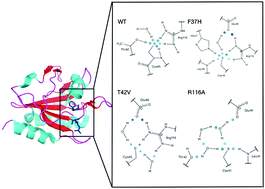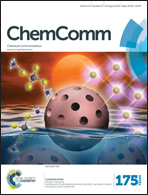The active site architecture in peroxiredoxins: a case study on Mycobacterium tuberculosis AhpE†
Abstract
Peroxiredoxins catalyze the reduction of peroxides, a process of vital importance to survive oxidative stress. A nucleophilic cysteine, also known as the peroxidatic cysteine, is responsible for this catalytic process. We used the Mycobacterium tuberculosis alkyl hydroperoxide reductase E (MtAhpE) as a model to investigate the effect of the chemical environment on the specificity of the reaction. Using an integrative structural (R116A – PDB 4XIH; F37H – PDB 5C04), kinetic and computational approach, we explain the mutational effects of key residues in its environment. This study shows that the active site residues are specifically oriented to create an environment which selectively favours a reaction with peroxides.


 Please wait while we load your content...
Please wait while we load your content...